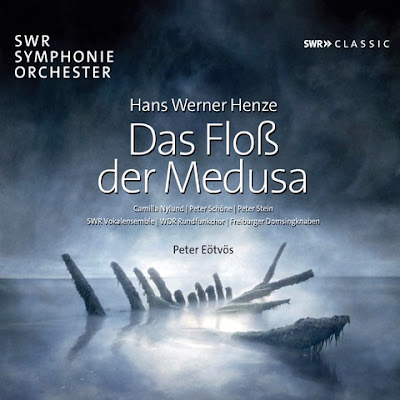 |
| Vladimir Jurowki and Julia Fischer with the London Philharmonic Orchestra in Beijing, March 2019 |
We'll miss Vladimir Jurowski when he moves on from the London Philharmonic Orchestra, after 18 years, 11 of these as Principal Conductor. Jurowski is a man who thinks deeply, creating programmes that are more than the sum of their parts, often venturing into repertoire off the beaten track. This concert at the Royal Festival Hall brought together Oliver Knussen (Scriabin Settings), Benjamin Britten (Violin Concerto) and Tchaikovsky (Symphony no 6, the "Pathétique")
Knussen's Scriabin Settings (from 1978) have recieved many performances over the years, most recently at the Knussen Memorial at Aldeburgh in June. Based on Scriabin's late miniatures for piano for small ensemble, Knussen's arrangement extends the colours without sacrificing transparency. Despite the chamber-like forces, "Désir" hints at what massed strings might sound like : an intriguing whisper, stirring the imagination. High, bright winds weave filigree patterns in "Nuances", leading seamlessly into "Caresse dansée" where the tones are darker and more sensual, leading to the livelier "Feuillet d'Album". In "Enigne" the flute danced brightly before the elusive conclusion. Though Scriabin is the muse, Knussen's Scriabin Settings are true Knussen territory : whimsical, open-hearted and aphoristic.
Julia Fischer was the soloist in Britten's Violin Concerto op 15, 1938-9. The introductory lines here were elegant, a brief moment of serenity before the agitato, where angular figures were underlined by percusion, suggesting gunfire. Spain had fallen to Franco, supported by the Nazis. To an anti-fascist like Britten, and many others, exile must have seemed the only hope for civilization. The Violin Concerto is a scream of anguish, so intense that it has affected reception.. It takes courage to write a deeply uncomforting statement like this. Perhaps only now can we appreciate its place in the canon of major works by a composer for whom cruelty and the loss of innocence were moral crimes. While the second movement begins vivace, the mood is bittersweet, Fischer recognizing the importance of the tight, tense pizzicato contradicting the sweep of the strings. Fischer platyed the long, meandering lines with melancholy, intensifying the contrast with the turbulent animando, where brass and timpani dominate. Nonetheless, the violin breaks free, true to itself, fast paced passages flying at high tessitura, above the darkness around it : hollow wood, the violin beaten like percussion, as if it were a folk instrument in a far away homeland, before a cadenza that soared above murmuring brass, the orchestra muted so it felt deliberately distant. Jurowski delineated the passacaglia so it felt like an anthem, undaunted and austere, rising (like the violin) ever upward. Thus fortified, the violin could reprise something of the confidence with which the piece began, Fischer playing with steady assurance, the orchestral strings like a chorale behind her. From the orchestral strings, a suggestion of guitars : the ghosts of the dead in Spain, rising again, led by the violin, marching quietly onward. Listening to the Violin Concerto, perhaps we can already hear Britten confronting the fundamental bleakness of the human condition, from which there is little escape.
By pairing Britten's Violin Concerto with Tchaikovsky's Symphony No. 6 in B minor, Op. 74, Jurowski highlighted the more disturbing aspects of the symphony. Because it's heard so often and sometimes receives performances that don't do it justice, the depth of its pathos aren't always done with the commitment that Jurowski brings to its interpretation. Wonderful colours, too, in the orchestral playing, enhancing the complex, shifting moods. The pulse in the third movement flowed with purpose, the march aspects defiant, like a march to the scaffold, undertaken without fear or regret. In the final movement a surging undertow grew in power, long string lines stretching as though the composer wanted to savour them for as long as possible before silence descended.
















